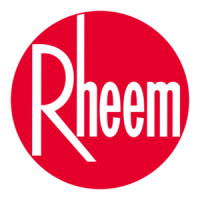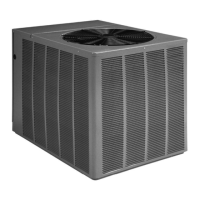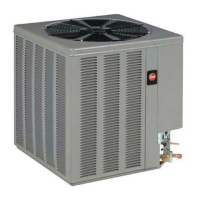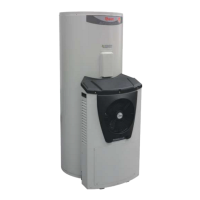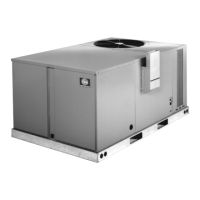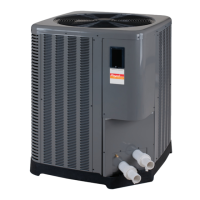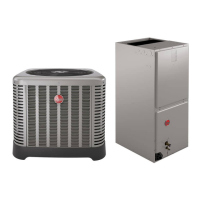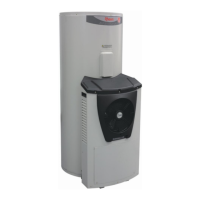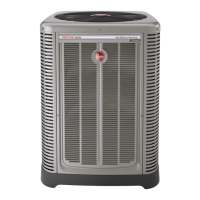30
Operation
6.0 NORMAL SEQUENCE OF OPERATION
The following sections provide details on how
the (-)P17 heat pump systems are designed
to operate under normal conditions. Under
abnormal conditions, Active Compressor and
Inverter Protection features built into the controls
may alter how the system operates to protect
the compressor and inverter from damage. The
sequence of operation is based on the system
being set up for EcoNet
TM
communications using
an EcoNet
TM
enabled air-handler or gas furnace
and an EcoNet
TM
Control Center. A section is
provided at the end that describes how the system
will operate if a conventional 24VAC 2-stage
thermostat is used.
NOTE: The use of a conventional 24VAC
thermostat eliminates many of the advanced
operating and diagnostic features the customer
has paid for and is therefore discouraged.
6.1 Cooling Mode
The EcoNet
TM
Control Center will determine
when cooling is necessary and the percentage
of capacity required. The Contol Center will then
communicate this information to the EcoNet
TM
Variable Speed Outdoor Control (VSODC)
which will direct the Power Inverter to ramp the
compressor up to the appropriate speed to meet
the required capacity percentage being requested.
There are 3 discrete capacity steps, minimum,
intermediate, and maximum. The percentage
of capacity required is based on the difference
between the temperature set-point and the room
temperature measured at the Control Center. One
second after the compressor starts, the VSODC
will direct the single speed outdoor motor to start.
The EcoNet
TM
Control Center will also direct the air-
handler or gas furnace control board to energize
the appropriate stage of air-flow for the compressor
capacity step being called for. This will be 1st
stage for the minimum or intermediate capacity
steps and 2nd stage for the maximum capacity
step. As the building load changes throughout the
call for cooling operation, the EcoNet
TM
Control
Center will direct the system to operate at the
appropriate capacity step. When the call for cooling
has ended, the compressor and outdoor fan motor
will be de-energized and the indoor blower motor
will ramp down to the minimum air-flow level for
30-45 seconds to extract the residual cooling from
the cold indoor coil before it stops.
6.2 On-Demand Cooling
Dehumidification
Note: Not Applicable to (-)H2T Air-Handlers
The EcoNet
TM
Control Center can be configured
for On-Demand Dehumidification for (-)HMV air-
handlers and (-)802V, (-)96V, (-)97V, and (-)98V
gas furnaces. This feature allows the system to
automatically increase the level of dehumidification
in the cooling mode by decreasing the indoor air-
flow by 15% when the indoor relative humidity
measured at the Control Center rises above the
set-point. Once the relative humidity drop to the
set-point, the indoor air-flow level returns to normal.
6.3 Low Ambient
Cooling Mode
Some applications require for space cooling
when the outdoor ambient temperature is below
normal (<55°F [13ºC]) such as a computer room
or an interior space with a heat source that must
be cooled. (-)P17 heat pumps are equipped with
a special low ambient cooling mode that allows
the system to provide cooling when the outdoor
temperature is below 55°F [13ºC] by cycling the
outdoor fan to maintain an adequate condensing
temperature and subcooling level based on an
input from the coil temperature thermistor.
6.4 Heating Mode
The EcoNet
TM
Control Center will determine
when heating is necessary and the percentage
of capacity required. The Control Center will then
communicate this information to the EcoNet
TM
Variable Speed Outdoor Control (VSODC)
which will direct the Power Inverter to ramp the
compressor up to the appropriate speed to meet
the required capacity percentage being requested.
The percentage of capacity required is based
on the difference between the temperature set-
point and the room temperature measured at
the Control Center. There are 3 discrete capacity
steps, minimum, intermediate, and maximum. The
percentage of capacity required is based on the
difference between the temperature set-point and
the room temperature measured at the Control
Center. One second after the compressor starts,
the VSODC will direct the single speed outdoor
motor to start. The EcoNet
TM
Control Center will
also direct the air-handler or gas furnace control
board to energize the appropriate stage of air-
flow for the compressor capacity step being
called for. This will be 1st stage for the minimum
or intermediate capacity steps and 2nd stage
for the maximum capacity step. As the building
load changes throughout the call for heating
operation, the EcoNet
TM
Control Center will
direct the system to operate at the appropriate
capacity step. Should the building load exceed
the capacity of the system when the outdoor
ambient temperature is below 32°F, the inverter will
direct the compressor to speed up and operate at
greater than 100% capacity (Overdrive Mode) in an
attempt to meet
